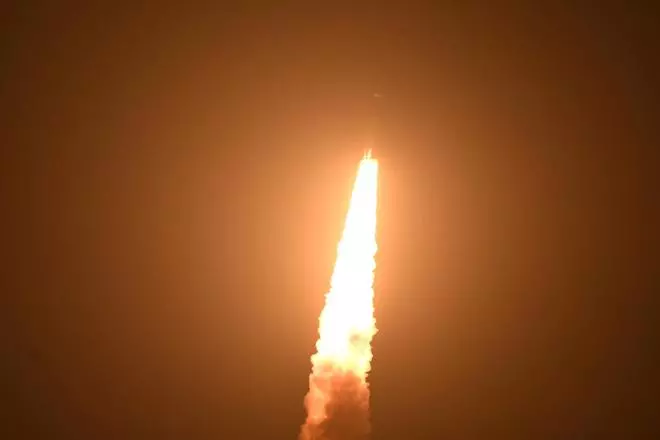The Diwali eve marked a historic moment for India’s space programme as a rocket of the Indian Space Research Organisation (ISRO) soared into the pitch-dark sky from the spaceport in Sriharikota carrying 36 satellites.
In the maiden commercial flight, India’s heavy-lift rocket GSLV MkIII — renamed for this mission as Launch Vehicle Mark-3 (LVM3-M2) — successfully placed all the satellites of the UK-based OneWeb into the intended orbits.
The text-book launch of the LVM3-M2 OneWeb India-1 Mission marks the success of the first dedicated commercial satellite mission of New Space India Ltd (NSIL). The LVM3-M2 has now made a strong entry into the global commercial launch service market.
Taking off at 12.07 am slowly from the second launch pad at the Satish Dhawan Space Centre, the rocket gained momentum with a thick orange frame in the rocket’s tail lighting up the sky. As the rocket slowly zoomed into the sky, it was visible over the Marina beach in a miniature form with an orange and blue flame in the tail.
The 36 satellites belonged to Network Access Associated Ltd (OneWeb) — a joint venture between India’s Bharti Global and the UK government. Sunil Mittal, CEO of Bharti Enterprises, watched the launch from ISRO’s mission control room along with Former ISRO chiefs K Sivan and AS Kiran Kumar.
SRO successfully launches 36 OneWeb satellites
Unique mission

As the rocket slowly zoomed into the sky, it was visible over the Marina beach in a miniature form with an orange and blue flame in the tail (B Jothi Ramalingam/The Hindu)
It was a unique mission as it demanded the separation of all 36 satellites into 601 km orbit with the separation to be sequenced in such a way that the customer requirement of a minimum 137 m distance between any payload satellite is met.
“This was achieved by orienting and reorienting the cryo stage using the onboard thrusters,” said S Unnikrishnan Nair, Director, Vikram Sarabhai Space Centre, Thiruvananthapuram, in a pre-recorded video.
Starting in 1999, ISRO had so far put into orbit 345 foreign satellites. The successful launch of 36 OneWeb satellites took the tally to 381.
ISRO Chairman S Somanath said from the control centre, “We have already started the (Diwali) celebration.”
It’s a historic mission and made possible because of Prime Minister Narendra Modi’s support as he wanted LVM3 to come into the commercial market, with NSIL in the forefront, to operationalise our launch vehicles for exploring and expanding the commercial domain, he said.
Mission Director Thaddeus Baskar told PTI, “Once the requirement was defined the entire team ISRO rose to the occasion, worked with full vigour. During the entire schedule, there was no room for sleep and everything has to be done right at the first time itself.”
The GSLV MkIII is a three-stage rocket with the first stage fired by solid fuel, the second by liquid fuel and the third is the cryogenic engine.
“The GSLV has made the most remarkable entry into the commercial launch service market,” said NSIL CMD D Radhakrishnan. “With this mission, we have shown to the entire world how to contract and execute the mission in less than four months,” he added.
Meanwhile, another set of 36 satellites from OneWeb is planned to be put into orbit in January 2023.
Many firsts of the mission
- First Commercial Mission of LVM3.
- First Multi-Satellite mission with 36 OneWeb Satellites onboard.
- First launch of LVM3 to Low Earth Orbit.
- First Indian rocket with six ton payload.
- First NSIL Mission with LVM3.
- First OneWeb Mission with NSIL/DoS.
(With inputs from PTI)








Comments
Comments have to be in English, and in full sentences. They cannot be abusive or personal. Please abide by our community guidelines for posting your comments.
We have migrated to a new commenting platform. If you are already a registered user of TheHindu Businessline and logged in, you may continue to engage with our articles. If you do not have an account please register and login to post comments. Users can access their older comments by logging into their accounts on Vuukle.